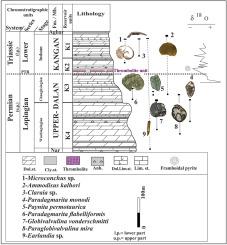Late Permian - Early Triassic transition in the carbonate-evaporite strata of the eastern part of the Qatar-Fars Arch, Persian Gulf basin
IF 3.6
2区 地球科学
Q1 GEOSCIENCES, MULTIDISCIPLINARY
引用次数: 0
Abstract
The carbonate – evaporite succession of the Permian upper part of the Dalan formation and the Lower Triassic Kangan formation was studied in four wells (A, C, E, and F) from four different fields situated east of the Qatar-Fars Arc in the central part of the Persian Gulf basin, offshore Iran. Foraminiferal species distribution enabled the establishment of the Paraglobivalvulina-Paradagmarita Assemblage zone assigned to the early Wuchiapingian-Changhsingian age. This biozone is divided into two subzones, the Wuchiapingian Globivalvulina vonderschimitti –Paraglobivalvulina aff. mira Assemblage subzone and the Changhsingian Paradagmarita monodi-P. flabelliformis-Paynita permotaurica Assemblage subzone in the upper member of the Dalan formation. The Microconchus-Claraia-Ammodiscus Assemblage zone was also established in the Kangan formation, indicative of an Early Triassic Induan age. The abundance of Paradagmarita monodi, P. flabelliformis in the upper member of the Dalan plays a significant role in paleobiogeographic sub-province correlation within the Neotethys realm. The final occurrence of foraminiferal genera from the Permian-Triassic boundary across all wells reveals a consistent stepwise extinction pattern between 10 and 5 m below the boundary. Furthermore, the presence of a thin thrombolite unit and small framboidal pyrite particles (5–10 μm in diameter) immediately above the Permian-Triassic Boundary (PTB) in wells A, C, F indicates the dominance of dysoxic conditions, which are consistent with a decrease in δ13C and δ18O values, coinciding with a rapid rise in water levels shortly after the extinction event.

波斯湾盆地卡塔尔-法尔斯拱门东部碳酸盐岩-蒸发岩地层的晚二叠世-早三叠世转变
在位于伊朗波斯湾盆地中部卡塔尔-法尔斯弧以东的四个不同油田的四口井(A、C、E和F)中,研究了二叠系Dalan组上部和下三叠系Kangan组的碳酸盐岩-蒸发岩演替。有孔虫的种类分布使五家坪纪—长兴纪早期的paraglobivalvulina—paradagmarita组合带得以建立。该生物带可划分为Wuchiapingian Globivalvulina vonderschimitti -Paraglobivalvulina affa . mira组合亚带和长兴ian Paradagmarita monodi-P两个亚带。大兰组上段flabelliforma - paynita permotaurica组合亚带。在Kangan组还建立了microconchus - claria - ammodiscus组合带,显示了早三叠世的Induan时代。大兰上段的paragmarita monodi, P. flabelliformis的丰度在新特提斯界的古地理亚省对比中具有重要意义。二叠纪-三叠纪界线的有孔虫属最终出现在所有井中,在界线以下10 ~ 5 m处显示出一致的逐步灭绝模式。此外,a、C、F井在二叠-三叠纪界线(PTB)上方出现了薄的凝块岩单元和小的树状黄铁矿颗粒(直径5 ~ 10 μm),表明缺氧条件占主导地位,这与δ13C和δ18O值下降一致,与灭绝事件发生后水位迅速上升一致。
本文章由计算机程序翻译,如有差异,请以英文原文为准。
求助全文
约1分钟内获得全文
求助全文
来源期刊

Marine and Petroleum Geology
地学-地球科学综合
CiteScore
8.80
自引率
14.30%
发文量
475
审稿时长
63 days
期刊介绍:
Marine and Petroleum Geology is the pre-eminent international forum for the exchange of multidisciplinary concepts, interpretations and techniques for all concerned with marine and petroleum geology in industry, government and academia. Rapid bimonthly publication allows early communications of papers or short communications to the geoscience community.
Marine and Petroleum Geology is essential reading for geologists, geophysicists and explorationists in industry, government and academia working in the following areas: marine geology; basin analysis and evaluation; organic geochemistry; reserve/resource estimation; seismic stratigraphy; thermal models of basic evolution; sedimentary geology; continental margins; geophysical interpretation; structural geology/tectonics; formation evaluation techniques; well logging.
 求助内容:
求助内容: 应助结果提醒方式:
应助结果提醒方式:


